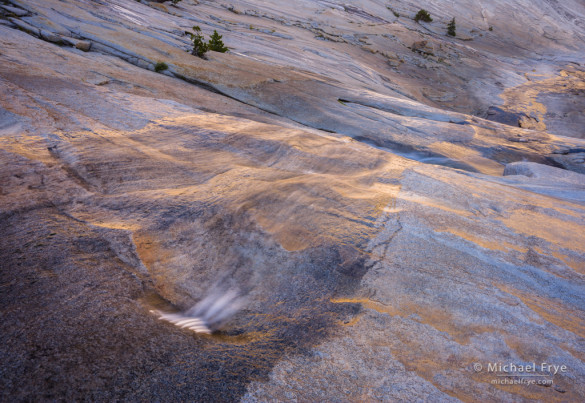
Creek descending through a granite basin. The sun was hitting the rocks just beyond the top of the frame, reflecting the gold color into the water, and even onto some of the polished rocks on the right.
When people think of photographing a reflection, they usually think of a mirror reflection, like a mountain reflected in a tranquil lake. I’ve done my share of those, but I think it’s often more interesting to just look at the colors, textures, and patterns on the water’s surface.
During my just-completed Hidden Yosemite workshop we had many opportunities to photograph reflections of all kinds. The accompanying photographs represent a mini-gallery of reflection photographs that I made during and just prior to the workshop, with extended captions to explain the thought process behind each image. Most of these are not mirror reflections; instead, they’re focused on the water’s colors and textures.
I think this is a pretty diverse collection, but there’s one thing all of these images have in common: in every case, the water was in the shade, but reflecting something in the sun. Sunlight on the water creates a glare that kills reflections. The magic happens when the water is in the shade, but reflecting the glow from sunlit mountains, rocks, trees, or clouds.
— Michael Frye
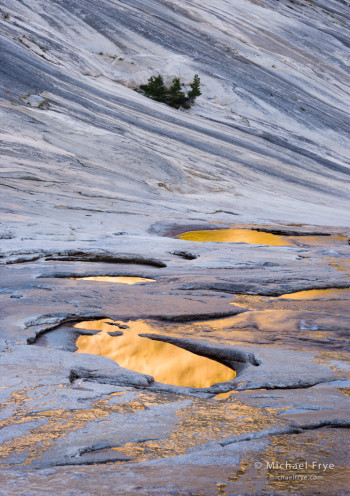
Pools in glacially polished granite, Yosemite NP. Late-day sunlight hitting the ridge above reflected gold colors into these pools of water. When adjusting the white balance, I left a hint of blue in the rocks to create a warm-cool color contrast.
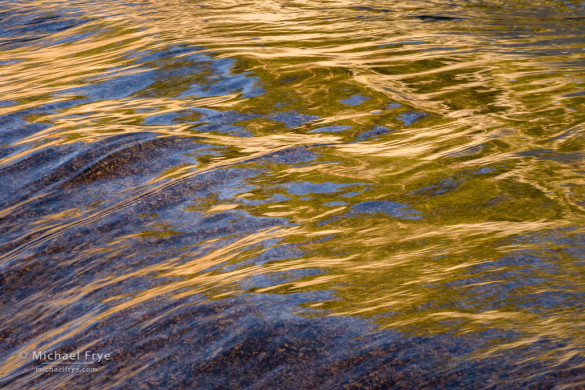
That gold color again, reflected into the Tuolumne River from sunlit rocks above. I used a relatively fast shutter speed – 1/60th sec. – to freeze the water’s motion and preserve the texture. I also needed a small aperture (f/22) to keep everything in focus. Getting both a fast shutter speed and small aperture required pushing the ISO up to 1600.
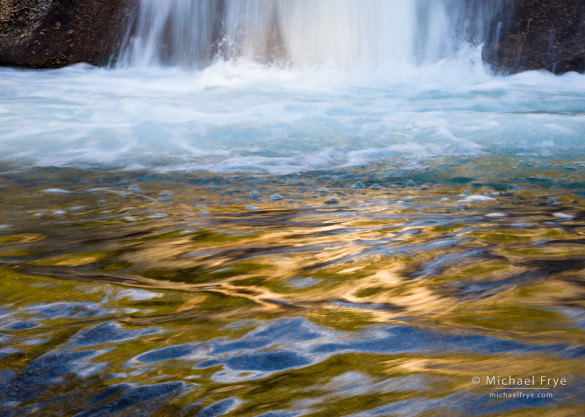
Reflections at the base of a small waterfall along the Tuolumne River. This shutter speed was a compromise: I wanted to freeze the ripples in the foreground, but blur the waterfall behind, so I settled on ⅛ of a second to get some blur while still preserving most of the texture in the ripples.
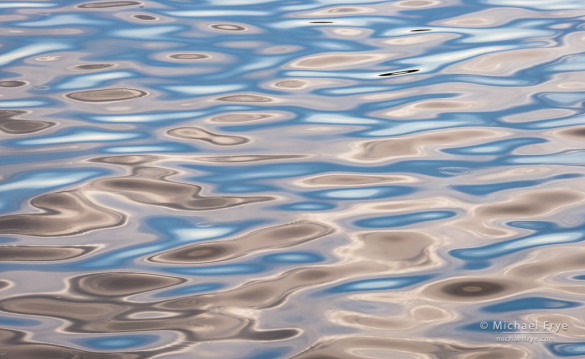
I loved the abstract patterns created by clouds reflected in the rippled surface of this alpine lake. Again I used a fast shutter speed (1/125 sec.) and small aperture (f/22) to freeze the motion and get sufficient depth of field, which required pushing the ISO to 400. The ripples were moving quickly, so I made a series of exposures with the same settings to try and capture the most interesting design.
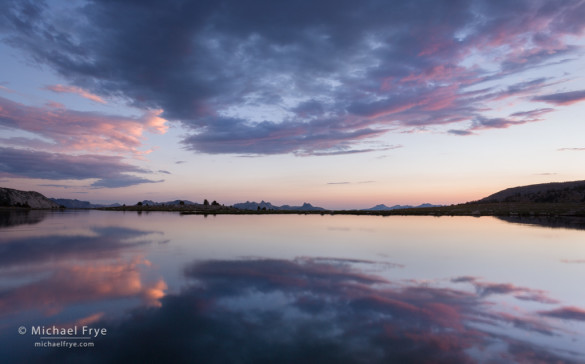
Sunset reflections in an alpine lake. The lake wasn’t perfectly still, but close enough to create a classic mirror reflection. In these situations shutter speed doesn’t matter much; here it was 1.5 seconds.
Related Posts: Where Should You Place the Horizon in Landscape Photographs?; Light and Mood With Intimate Landscapes
Michael Frye is a professional photographer specializing in landscapes and nature. He is the author and photographer of The Photographer’s Guide to Yosemite, Yosemite Meditations, and Digital Landscape Photography: In the Footsteps of Ansel Adams and the Great Masters, plus the eBooks Light & Land: Landscapes in the Digital Darkroom, and Exposure for Outdoor Photography. He has written numerous magazine articles on the art and technique of photography, and his images have been published in over thirty countries around the world. Michael has lived either in or near Yosemite National Park since 1983, currently residing just outside the park in Mariposa, California.









Thank you Michael for a wonderful week of self-discovery surrounded by tranquil beauty in the High Country of Yosemite. I got to experience first hand how you get these wonderful pictures on your blog. It was my first workshop with you and definitely one of the best in the photographic life. I learned not only the technique but also the art of photography so that I can shoot from emotions that are awakened by nature’s beauty!
Thanks for the kind words Karl. I’m very glad you enjoyed the workshop, and it was great having you with us! Wonderful group all around, and a really fun week.
I’ll be heading up that way in a couple of weeks…looking at all your wonderful images made me wonder, how a filter, specifically the Singh-Ray Blue & Gold filter, would have added anything? I am an avid amateur and have that filter, although I’ve used it very sporadically. Love looking at your work and getting inspiration…thanks!
Susan, personally I’m not a fan of the blue and gold filter. To me it doesn’t create better colors, just weird colors.
I put mine away along time ago because the colors were too bizarre and not realistic!
Just read through your post about photographing the Milky Way…Soooo excited to make a first attempt at this…my timing is perfect for August 6 & 7th up in the Yosemite high country. Now I need to figure out a good spot to try it.
Glad you liked that post Susan. Good luck!
Hi Michael, all photos look great but the second one with the reflection is the pools is just outstanding! Cheers, Sandra
Glad you like that image Sandra – thanks!
I really like the next to last photograph, with the pattern of the reflected clouds, very beautiful.
Thank you Lenya!
Michael,
Beautiful work! I have always felt that one of the things that separates landscape photographers from the casual observer is seeing things in nature that others tend to overlook. These images support that hypothesis and you do it very well.
Thanks very much James! Sometimes an image can work on the level of a “visual surprise” – showing something unexpected.
I love that glacially polished granite photo with the pools. Great contrast! I have been searching for a river or stream detail photo showing warm reflected light…..have not yet found such a composition but this post reminds me to keep looking 🙂
Thanks Eric! You just need to look for situations where the sun is hitting trees/hill/mountain above the river or stream. The sun should be at your back, more or less, and it has to be early or late in the day.
Hi Michael, great images! I just returned from shooting around Lake Tahoe, which presents many of the same type of opportunities. The water is very clear, which makes for some great reflection shots. Also used your advice from a previous article on how to line up bolder or rock formations to make for a better composition. Well timed! I look forward to showing you a few images from this shoot when I see you on the next workshop. Take care and say hi to Claudia!
Thanks Marc, and I’m glad the tips about separation helped with your Lake Tahoe images. I look forward to seeing them!
Great shots, Michael. I especially like the second and agree with your color balance. On a sort of related subject of reflections, what is your view on polarizing filters? I know in this shot it would probably kill the reflection, but sometimes I find a minimal setting on the filter often enhances the other subjects in a scene w/o really killing the reflection. It sometimes allows for more color to show through from something else in the scene. I usually have mine glued to the lens, since I use it so often, then just tune it out when I don’t need it. I know I take and exposure hit, and if the hit is unacceptable, I remove it. But I would like to know your views. Do you use it rarely or often? How do you decide?
Thanks for a great post.
Aram
Thanks Aram. I use polarizing filters fairly often, but don’t keep a polarizer on at all times, and didn’t use one in any of these photos. As you said, it would cut the reflections, which is the opposite of what I wanted. Plus, in many of these images I needed a fast shutter speed and small aperture, and losing two stops of light with the polarizer would be make that more difficult.
I’m loving your shots of the reflections in the Alpine lake. I can’t wait to go through all of mine to see if any of them came out with great patterns. This was the best workshop I’ve ever taken and hope to sign up for some more. You are a fantastic teacher as well as photographer and with all the information you provided I hope to improve on my technique and eye for beauty. Thank you again. Dawn
Thanks very much Dawn! Glad you like that photo, and I hope you find something just as good or better among your photos from that day. And thanks for the kind words about the workshop. I’m really glad you enjoyed it. For my part, it was a pleasure having you with us, and thanks for keeping me company during the drives! 🙂 Hope to see you again soon.
Beautiful images! You have a truly unique vision, and its a breath of fresh air. Landscape photography can seem so homogeneous lately!
Thanks so much Matt!